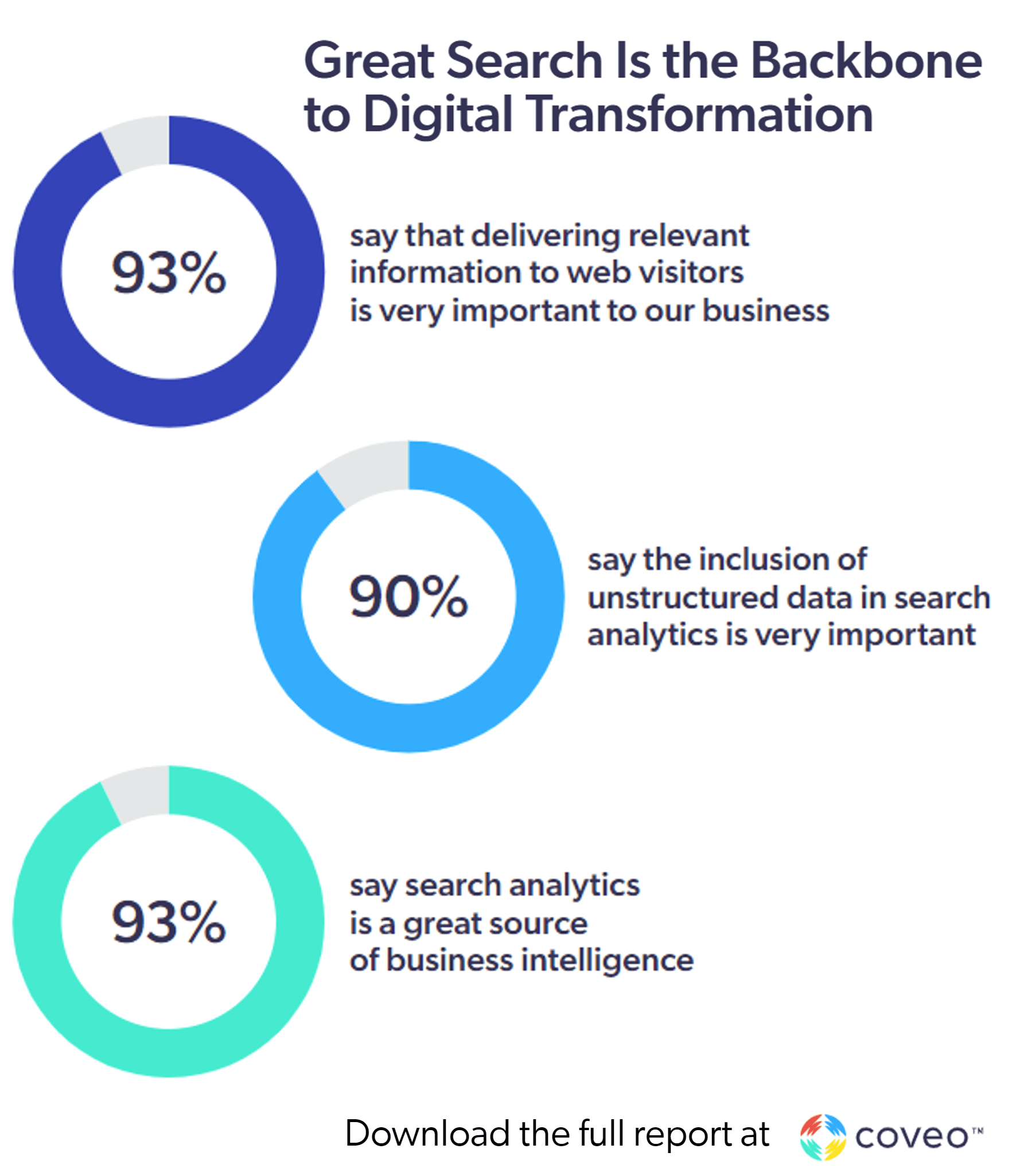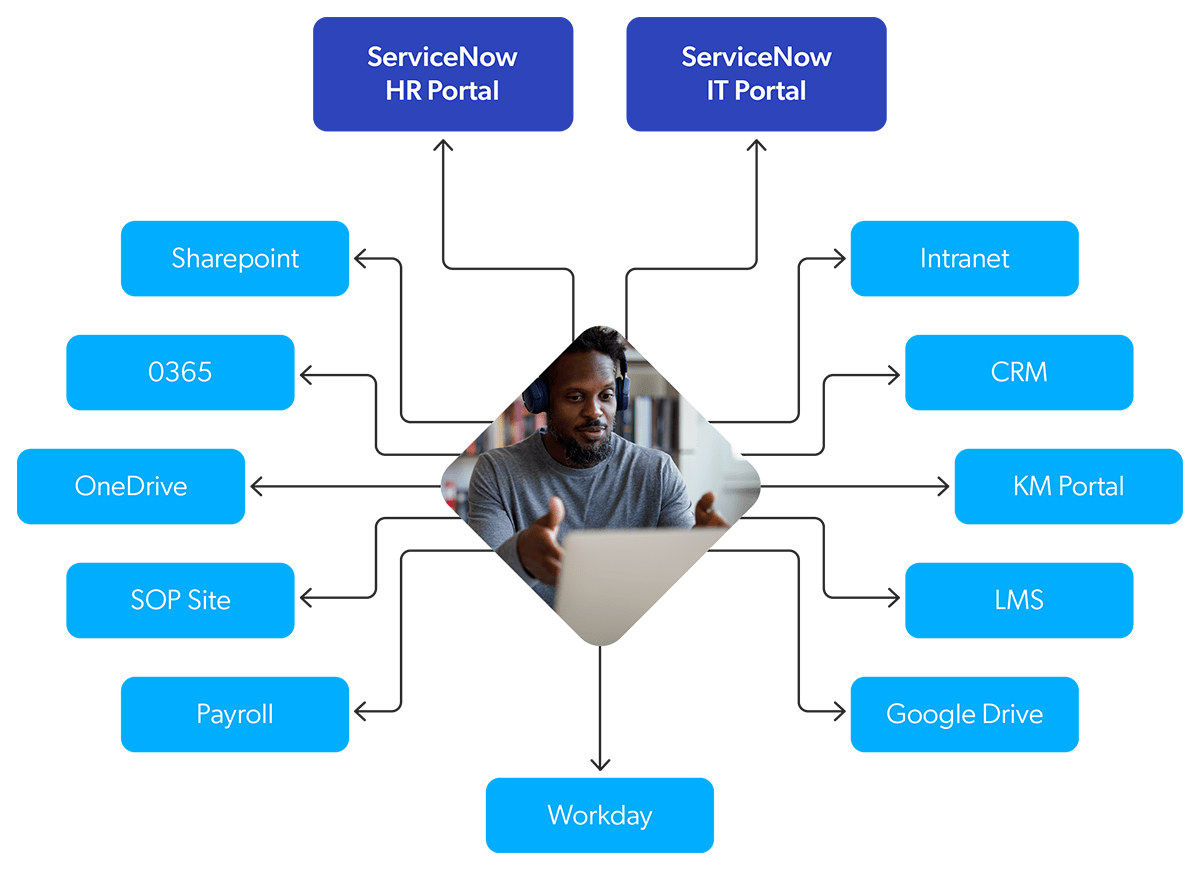According to a survey of 600 IT professionals, 84% see search as critical to driving digital transformation. If nothing else, strong enterprise search supports the delivery of relevant information to web visitors, something 94% of respondents say is very important to their business.
The data strongly suggest the will is there to make enterprise search a priority.

As for the execution …
The reality is that many organizations still face distinct challenges in managing and deriving true value from enterprise search technology.
For Users and Developers, Relevant Search Remains Elusive
On the one hand, it’s quite difficult to meet people’s expectations for search experiences when information is spread across numerous applications and systems. Even with an enterprise search solution in place, siloed information can render search results disappointing, frustratingly generic, or even useless.
This is borne out by our Workplace Relevance Report 2022, where IT workers reported spending an average of 4.2 hours a day seeking relevant information. Clearly, enterprise search wasn’t what it should have been, and this is but one data point of many.
On the flip side, in-house IT pros and developers struggle with managing their companies’ enterprise search capabilities. It’s not easy to juggle multiple legacy technologies, some of which might have been custom-built to meet certain needs at the time of installation. Add to the mix the challenges of making disparate, complex systems work together, and you’ve got a real headache on your hands.
5 Obstacles Faced by Enterprise Search Developers
Let’s look more closely at the top issues faced by development with their current enterprise search systems—and how the right unified search technology can mitigate them.
The Headache of Managing Multiple Search Systems
At least 68% of survey respondents indicated that “integrating multiple systems” is a major challenge. Each technology has its own query languages, ranking models, and configurations. And all are difficult to master and sync for time-and-labor-strapped IT teams, let alone stitching them all together in a cohesive manner suitable for use across the enterprise.

Issues with Infrastructure Management
This is yet another core challenge bogging down enterprise search initiatives. Fifty-nine percent of survey respondents noted issues with data volume, cleaning data, or data indexing. In addition, 55% of respondents struggle with managing unstructured data, while 47% note the security of data as a top challenge.
And then there are the ripple effects of trying to tune different search solutions. Many organizations bump up against the sheer complexity of each system’s installation and maintenance. Despite advances in technology, many vendors’ infrastructures are hard to manage. IT needs to provide the proper hardware, install the vendor’s software, manage updates, upscale or downscale when needed, and support several Search APIs.
That 29% of survey respondents struggle with managing a cloud deployment model for enterprise search is indicative of broader challenges to infrastructure management.
And, as demand rises for ease-of-use, speed, functionalities, and relevance, IT must coordinate with vendors to make not only the front-end experience increasingly useful but also the backend integrations more seamless.
It’s a hard-won endeavor.
Tackling Multiple Indices
Conventional enterprise search systems also require that content be split into several indexes. This is due in part to limited filter capabilities and security constraints. Or you struggle to align multiple departments, each with their own index and taxonomy management. Two people searching in the same system with the same query can each get different results depending on permission levels.
For 42% of survey respondents, keeping up with metadata is a significant technical challenge, while 33% struggle to navigate knowledge management system taxonomy. Which is not surprising: with multiple indexes comes the need to maintain them (in real-time) with the latest changes to content and data. Each system will have their own requirements on how and when the updates should be processed.
Using Open Source Search Engines: Not All It’s Cracked Up to Be
Build versus buy is a complicated topic when it comes to search engines. Depending on a company’s need, custom search like Solr or Elastic can seem like a good idea. You get control over everything, from planning the infrastructure, sourcing the data, and (most importantly to some) ensuring the security of your information.
Yet, packaged with great ability is great responsibility — that is, expertise.
As beneficial as open source search engines might seem, 99% of our respondents say they’re still manually tuning search. The survey also found that enterprises routinely customize search results based on role-based controls (63%), historical aggregate data (62%), real-time data (51%), and location (42%).
Companies often erroneously think that by using open-source enterprise search solutions, they are saving money and benefiting from ever-evolving code. Yet open source search systems require much fine-tuning to get the most out of them.
As a result, many enterprises don’t implement certain search queries at all. According to the report, less than 29% of respondents implement any of the nine core search queries (factoid, similar to, etc.) “very well”. More than a third of all respondents are trying to implement these critical search queries, but having issues:
- Natural language query (37%)
- Meta knowledge (36%)
- Compound nouns (34%)
- Nouns vs. verbs (32%)
- Disambiguation (30%)
In the end, open source systems can’t be learned in a day. Compatibility issues can occur when integrating open-source search with other proprietary platforms.
Difficulty Tapping Into Search Analytics
There’s no question that IT pros and developers understand the value of search analytics. The report found that 90% of respondents say the inclusion of unstructured data in search analytics is very important, while 93% say search analytics is a great source of business intelligence.
That said, more than half of the same professionals say their organizations struggle to find data analysts and search data analysts. And yet many enterprise search systems don’t offer real-time information into user behavior. What’s more, many enterprise search systems lack sophisticated artificial intelligence that helps humans leverage this data at scale.
How do you resolve content gaps if you can’t mind the gap? And how can you tune search if you don’t have reliable search analytics (and the people to interpret them)?
How IT Pros Can Finally Conquer these Enterprise Search Obstacles
If you’re among the 88% of IT professionals that have seen search deployments either disrupted with occasional issues, or complicated by regular problems, you understand the consequences of inadequate enterprise search.
But for the five challenges faced by enterprise search initiatives, we do have some solutions.
1. Unify Disparate Systems
A unified search engine eliminates the hassles of using multiple search technologies. Using connectors, these engines actually layer over existing systems, centralizing results from a wide range of applications for both structured and unstructured content.
Search hubs and query pipelines are key in surfacing results across multiple touchpoints. Teams can therefore focus on managing one unified search platform, using a single interface for configuration.
Coveo only shows documents to those who have permission to view them, preserving content governance.
2. Centralize Systems Management
Unified search platforms are often available as SaaS solutions. Providers manage infrastructure setup and management. This offers a reduced time-to-benefit, lower total cost of ownership, flexible scalability, and a single Search API.
3. Bring All Indices Into a Single Index
A unified search engine indexes document-level security, removing the need to create different indexes. Content can be stored in a single instance where IT can set filters on the content to be retrieved. Connectors can support incremental indexing. New data and content is available as fast as the index can be regenerated.
4. Ditch the Open Source Conundrum
IT teams should ideally leverage a unified search platform that can provide powerful insights into the search paths taken by individual users—and ultimately create better, more unified search experiences across the organization.
Out-of-the-box AI-powered search platforms are much easier to tune because that tuning occurs on the content retrieval level. This is where the beauty of customization comes in. Coveo, for example, provides JavaScript and headless interfaces to enable IT teams to build user interfaces with ease.
5. Simplify and Enhance Your Search Analytics
By combining AI and data, along with analytics tools that provide transparency and insight for decision making, search architects can perfect search and results interfaces, as well as better understand the intent behind people’s queries. Coveo provides in-depth analytics reporting that helps prevent zero-result searches, advanced search metrics, and enables A/B testing.
Dig Deeper
What we’re looking for is low code development, automation, and elastic computing. We’re looking for means to optimize digital experiences faster, even if technical teams are resource constrained.
Not all enterprise search solutions are the same, and neither are enterprise search needs. We’re here to help you find one that fits your audience’s DX needs and scales. Check out our buyer’s guide that will help you evaluate different options on the market.
It’ll walk you through fundamental concepts and how to decipher which solution is your enterprise’s next search engine.
Dig Deeper
Ready to move beyond the conceptual? Here’s a list of the 10 must-have features you should look for in a relevance platform.
Or if you’d like to get hands on, give our free 30-day trial a spin!


